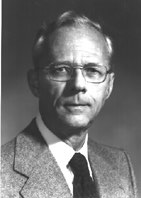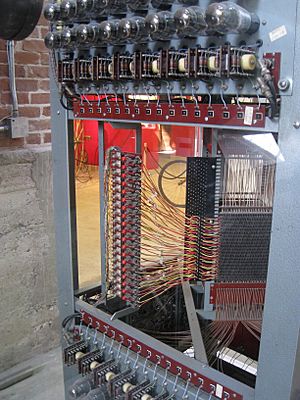Jay Wright Forrester facts for kids
Quick facts for kids
Jay Wright Forrester
|
|
|---|---|
 |
|
| Born | July 14, 1918 |
| Died | November 16, 2016 (aged 98) |
| Alma mater | University of Nebraska–Lincoln (B.S., 1939) MIT |
| Known for |
|
| Awards |
|
| Scientific career | |
| Institutions | MIT Sloan School of Management (1956) |
Jay Wright Forrester (born July 14, 1918 – died November 16, 2016) was a very smart American engineer. He helped create early computers and understand how complex systems work. He is famous for inventing magnetic core memory. This was a super important type of computer memory. It was used in computers for many years, especially between 1955 and 1975. This invention helped computers become much faster and better.
Jay Forrester is also thought to have made the first computer animation ever! It was a simple "jumping ball" shown on a special screen called an oscilloscope.
Later in his career, he became a professor at MIT Sloan School of Management. There, he explained something called the Forrester effect. This effect describes how small changes can cause big ups and downs in supply chains. He also started a field of study called system dynamics. This field uses computers to understand how different parts of a system, like a business or a city, work together.
Early Life and Education
Jay Forrester was born on a farm in Anselmo, Nebraska. He became interested in electricity because his family's farm didn't have any. When he was in high school, he even built a wind-powered electricity system for his farm! He used old car parts to make it work. This gave his family's ranch its first electric power.
In 1939, Forrester earned his first degree in Electrical Engineering from the University of Nebraska–Lincoln. Later, he was honored by a special engineering society. He then went to MIT for more studies. He stayed at MIT for his entire career, making many important discoveries.
Amazing Career Contributions
Whirlwind Project and Computer Memory
In the 1940s and early 1950s, Jay Forrester did important research at MIT. He led a big project called the Whirlwind project. During this time, he made magnetic-core memory much better. He also developed a special system for storing digital information. This system was the early version of today's RAM, which is in almost every computer.
As mentioned, he is also believed to have created the very first computer animation. It was a simple "jumping ball" that moved on an oscilloscope screen.
The Forrester Effect
In 1956, Forrester moved to the MIT Sloan School of Management. He became a professor there. In 1961, he wrote about something he called the Forrester effect. This effect explains how small changes in customer demand can cause much bigger changes further down a supply chain. Today, this is often called the "bullwhip effect." It helps businesses understand how to manage their products better.
For his important work, Jay Forrester received many awards. In 1972, he got the IEEE Medal of Honor, which is a very high award in engineering. In 1995, he was recognized by the Computer History Museum. This was for making core memory a practical computer memory device. It was also for his big contributions to early computer design.
Understanding Systems with System Dynamics
Jay Forrester started a new field of study called system dynamics. This is a way to use computer models to understand how different parts of a complex system interact. It helps people see how things change over time.
His first book using system dynamics was Industrial Dynamics. It looked at how businesses grow and change. Later, he worked with the former Mayor of Boston, John F. Collins. This led him to write Urban Dynamics. This book explored how to use system dynamics to understand problems in cities. It even influenced the popular video game SimCity!
Forrester's ideas about modeling systems also caught the attention of a group called the Club of Rome. He met with them to talk about global issues like the economy, population, and the environment. This led to his book World Dynamics. This book used system dynamics to model how the world's economy, population, and environment interact. This was a big step in the field of global modeling. Forrester continued to promote system dynamics. He believed it could help solve many real-world problems and improve education.
Images for kids
See also
 In Spanish: Jay Forrester para niños
In Spanish: Jay Forrester para niños



